A Daily Accumulation Model for Predicting PFOS Residues in Beef Cattle Muscle After Oral Exposure
Abstract
1. Introduction
2. Materials and Methods
2.1. Parameters
2.1.1. PFOS Half-Life
2.1.2. Muscle:Body PFOS Ratio
2.1.3. Weight and Growth
2.1.4. Forage and Milk Intake for Nursing Calves
2.1.5. Forage Intake from Birth to Slaughter
2.1.6. Soil and Water Intake
2.2. Monte Carlo Analysis
2.3. Case Studies
3. Results
3.1. Case Study 1
3.2. Case Study 2
4. Discussion
Generic Model
5. Conclusions
Supplementary Materials
Author Contributions
Funding
Institutional Review Board Statement
Data Availability Statement
Acknowledgments
Conflicts of Interest
References
- Buck, R.C.; Franklin, J.; Berger, U.; Conder, J.M.; Cousins, I.T.; De Voogt, P.; Jensen, A.A.; Kannan, K.; Mabury, S.A.; Van Leeuwen, S.P. Perfluoroalkyl and Polyfluoroalkyl Substances in the Environment: Terminology, Classification, and Origins. Integr. Environ. Assess. Manag. 2011, 7, 513–541. [Google Scholar] [CrossRef] [PubMed]
- Sunderland, E.M.; Hu, X.C.; Dassuncao, C.; Tokranov, A.K.; Wagner, C.C.; Allen, J.G. A Review of the Pathways of Human Exposure to Poly- and Perfluoroalkyl Substances (PFASs) and Present Understanding of Health Effects. J. Expo. Sci. Environ. Epidemiol. 2019, 29, 131–147. [Google Scholar] [CrossRef]
- Sznajder-Katarzyńska, K.; Surma, M.; Cieślik, I. A Review of Perfluoroalkyl Acids (PFAAs) in Terms of Sources, Applications, Human Exposure, Dietary Intake, Toxicity, Legal Regulation, and Methods of Determination. J. Chem. 2019, 1–20. [Google Scholar] [CrossRef]
- Clarke, B.O.; Smith, S.R. Review of ‘Emerging’ Organic Contaminants in Biosolids and Assessment of International Research Priorities for the Agricultural Use of Biosolids. Environ. Int. 2011, 37, 226–247. [Google Scholar] [CrossRef]
- Fernandes, A.R.; Lake, I.R.; Dowding, A.; Rose, M.; Jones, N.R.; Petch, R.; Smith, F.; Panton, S. The Potential of Recycled Materials Used in Agriculture to Contaminate Food through Uptake by Livestock. Sci. Total Environ. 2019, 667, 359–370. [Google Scholar] [CrossRef]
- Blaine, A.C.; Rich, C.D.; Sedlacko, E.M.; Hundal, L.S.; Kumar, K.; Lau, C.; Mills, M.A.; Harris, K.M.; Higgins, C.P. Perfluoroalkyl Acid Distribution in Various Plant Compartments of Edible Crops Grown in Biosolids-Amended Soils. Environ. Sci. Technol. 2014, 48, 7858–7865. [Google Scholar] [CrossRef] [PubMed]
- Loganathan, B.G.; Sajwan, K.S.; Sinclair, E.; Senthil Kumar, K.; Kannan, K. Perfluoroalkyl Sulfonates and Perfluorocarboxylates in Two Wastewater Treatment Facilities in Kentucky and Georgia. Water Res. 2007, 41, 4611–4620. [Google Scholar] [CrossRef] [PubMed]
- Link, G.W.; Reeves, D.M.; Cassidy, D.P.; Coffin, E.S. Per- and Polyfluoroalkyl Substances (PFAS) in Final Treated Solids (Biosolids) from 190 Michigan Wastewater Treatment Plants. J. Hazard. Mater. 2024, 463, 132734. [Google Scholar] [CrossRef]
- Yoo, H.; Washington, J.W.; Jenkins, T.M.; Ellington, J.J. Quantitative Determination of Perfluorochemicals and Fluorotelomer Alcohols in Plants from Biosolid-Amended Fields Using LC/MS/MS and GC/MS. Environ. Sci. Technol. 2011, 45, 7985–7990. [Google Scholar] [CrossRef]
- Hu, X.C.; Ge, B.; Ruyle, B.J.; Sun, J.; Sunderland, E.M. A Statistical Approach for Identifying Private Wells Susceptible to Perfluoroalkyl Substances (PFAS) Contamination. Environ. Sci. Technol. Lett. 2021, 8, 596–602. [Google Scholar] [CrossRef]
- Lindstrom, A.B.; Strynar, M.J.; Libelo, E.L. Polyfluorinated Compounds: Past, Present, and Future. Environ. Sci. Technol. 2011, 45, 7954–7961. [Google Scholar] [CrossRef]
- United States Environmental Protection Agency. USEPA Technical Fact Sheet: Drinking Water Health Advisories for Four PFAS (PFOA, PFOS, GenX Chemicals, and PFBS); United States Environmental Protection Agency: Washington, DC, USA, 2022.
- Chen, W.-L.; Bai, F.-Y.; Chang, Y.-C.; Chen, P.-C.; Chen, C.-Y. Concentrations of Perfluoroalkyl Substances in Foods and the Dietary Exposure among Taiwan General Population and Pregnant Women. J. Food Drug Anal. 2018, 26, 994–1004. [Google Scholar] [CrossRef] [PubMed]
- Tittlemier, S.A.; Pepper, K.; Seymour, C.; Moisey, J.; Bronson, R.; Cao, X.-L.; Dabeka, R.W. Dietary Exposure of Canadians to Perfluorinated Carboxylates and Perfluorooctane Sulfonate via Consumption of Meat, Fish, Fast Foods, and Food Items Prepared in Their Packaging. J. Agric. Food Chem. 2007, 55, 3203–3210. [Google Scholar] [CrossRef]
- De Silva, A.O.; Armitage, J.M.; Bruton, T.A.; Dassuncao, C.; Heiger-Bernays, W.; Hu, X.C.; Kärrman, A.; Kelly, B.; Ng, C.; Robuck, A.; et al. PFAS Exposure Pathways for Humans and Wildlife: A Synthesis of Current Knowledge and Key Gaps in Understanding. Environ. Toxicol. Chem. 2021, 40, 631–657. [Google Scholar] [CrossRef]
- Vestergren, R.; Berger, U.; Glynn, A.; Cousins, I.T. Dietary Exposure to Perfluoroalkyl Acids for the Swedish Population in 1999, 2005 and 2010. Environ. Int. 2012, 49, 120–127. [Google Scholar] [CrossRef]
- Yu, C.H.; Riker, C.D.; Lu, S.; Fan, Z. Biomonitoring of Emerging Contaminants, Perfluoroalkyl and Polyfluoroalkyl Substances (PFAS), in New Jersey Adults in 2016–2018. Int. J. Hyg. Environ. Health 2020, 223, 34–44. [Google Scholar] [CrossRef]
- Genualdi, S.; Young, W.; Peprah, E.; Srigley, C.; Fisher, C.M.; Ng, B.; deJager, L. Analyte and Matrix Method Extension of Per- and Polyfluoroalkyl Substances in Food and Feed. Anal. Bioanal. Chem. 2024, 416, 627–633. [Google Scholar] [CrossRef]
- Noorlander, C.W.; Van Leeuwen, S.P.J.; Te Biesebeek, J.D.; Mengelers, M.J.B.; Zeilmaker, M.J. Levels of Perfluorinated Compounds in Food and Dietary Intake of PFOS and PFOA in The Netherlands. J. Agric. Food Chem. 2011, 59, 7496–7505. [Google Scholar] [CrossRef]
- Guo, W.; Pan, B.; Sakkiah, S.; Yavas, G.; Ge, W.; Zou, W.; Tong, W.; Hong, H. Persistent Organic Pollutants in Food: Contamination Sources, Health Effects and Detection Methods. Int. J. Environ. Res. Public Health 2019, 16, 4361. [Google Scholar] [CrossRef]
- Bedi, M.; Sapozhnikova, Y.; Taylor, R.B.; Ng, C. Per- and Polyfluoroalkyl Substances (PFAS) Measured in Seafood from a Cross-Section of Retail Stores in the United States. J. Hazard. Mater. 2023, 459, 132062. [Google Scholar] [CrossRef] [PubMed]
- Young, W.; Wiggins, S.; Limm, W.; Fisher, C.M.; DeJager, L.; Genualdi, S. Analysis of Per- and Poly(Fluoroalkyl) Substances (PFASs) in Highly Consumed Seafood Products from U.S. Markets. J. Agric. Food Chem. 2022, 70, 13545–13553. [Google Scholar] [CrossRef]
- Fenton, S.E.; Ducatman, A.; Boobis, A.; DeWitt, J.C.; Lau, C.; Ng, C.; Smith, J.S.; Roberts, S.M. Per- and Polyfluoroalkyl Substance Toxicity and Human Health Review: Current State of Knowledge and Strategies for Informing Future Research. Environ. Toxicol. Chem. 2021, 40, 606–630. [Google Scholar] [CrossRef]
- Loccisano, A.E.; Campbell, J.L.; Andersen, M.E.; Clewell, H.J. Evaluation and Prediction of Pharmacokinetics of PFOA and PFOS in the Monkey and Human Using a PBPK Model. Regul. Toxicol. Pharmacol. 2011, 59, 157–175. [Google Scholar] [CrossRef]
- Lau, C.; Butenhoff, J.L.; Rogers, J.M. The Developmental Toxicity of Perfluoroalkyl Acids and Their Derivatives. Toxicol. Appl. Pharmacol. 2004, 198, 231–241. [Google Scholar] [CrossRef]
- Biegel, L.B.; Hurtt, M.E.; Frame, S.R.; O’Connor, J.C.; Cook, J.C. Mechanisms of Extrahepatic Tumor Induction by Peroxisome Proliferators in Male CD Rats. Toxicol. Sci. 2001, 60, 44–55. [Google Scholar] [CrossRef]
- Butenhoff, J.L.; Kennedy, G.L.; Frame, S.R.; O’Connor, J.C.; York, R.G. The Reproductive Toxicology of Ammonium Perfluorooctanoate (APFO) in the Rat. Toxicology 2004, 196, 95–116. [Google Scholar] [CrossRef]
- Andersen, M.E.; Butenhoff, J.L.; Chang, S.-C.; Farrar, D.G.; Kennedy, G.L.; Lau, C.; Olsen, G.W.; Seed, J.; Wallace, K.B. Perfluoroalkyl Acids and Related Chemistries—Toxicokinetics and Modes of Action. Toxicol. Sci. 2008, 102, 3–14. [Google Scholar] [CrossRef]
- Conder, J.M.; Hoke, R.A.; Wolf, W.D.; Russell, M.H.; Buck, R.C. Are PFCAs Bioaccumulative? A Critical Review and Comparison with Regulatory Criteria and Persistent Lipophilic Compounds. Environ. Sci. Technol. 2008, 42, 995–1003. [Google Scholar] [CrossRef]
- Olsen, G.W.; Burris, J.M.; Ehresman, D.J.; Froehlich, J.W.; Seacat, A.M.; Butenhoff, J.L.; Zobel, L.R. Half-Life of Serum Elimination of Perfluorooctanesulfonate, Perfluorohexanesulfonate, and Perfluorooctanoate in Retired Fluorochemical Production Workers. Environ. Health Perspect. 2007, 115, 1298–1305. [Google Scholar] [CrossRef]
- Jones, P.D.; Hu, W.; De Coen, W.; Newsted, J.L.; Giesy, J.P. Binding of Perfluorinated Fatty Acids to Serum Proteins. Environ. Toxicol. Chem. 2003, 22, 2639–2649. [Google Scholar] [CrossRef]
- Han, X.; Snow, T.A.; Kemper, R.A.; Jepson, G.W. Binding of Perfluorooctanoic Acid to Rat and Human Plasma Proteins. Chem. Res. Toxicol. 2003, 16, 775–781. [Google Scholar] [CrossRef]
- Kudo, N.; Katakura, M.; Sato, Y.; Kawashima, Y. Sex Hormone-Regulated Renal Transport of Perfluorooctanoic Acid. Chem. Biol. Interact. 2002, 139, 301–316. [Google Scholar] [CrossRef] [PubMed]
- Ylinen, M.; Kojo, A.; Hanhijärvi, H.; Peura, P. Disposition of Perfluorooctanoic Acid in the Rat after Single and Subchronic Administration. Bull. Environ. Contam. Toxicol. 1990, 44, 46–53. [Google Scholar] [CrossRef]
- Benskin, J.P.; De Silva, A.O.; Martin, L.J.; Arsenault, G.; McCrindle, R.; Riddell, N.; Mabury, S.A.; Martin, J.W. Disposition of Perfluorinated Acid Isomers in Sprague-Dawley Rats; Part 1: Single Dose. Environ. Toxicol. Chem. 2009, 28, 542–554. [Google Scholar] [CrossRef]
- Butenhoff, J.L. Pharmacokinetics of Perfluorooctanoate in Cynomolgus Monkeys. Toxicol. Sci. 2004, 82, 394–406. [Google Scholar] [CrossRef]
- Bartell, S.M.; Calafat, A.M.; Lyu, C.; Kato, K.; Ryan, P.B.; Steenland, K. Rate of Decline in Serum PFOA Concentrations after Granular Activated Carbon Filtration at Two Public Water Systems in Ohio and West Virginia. Environ. Health Perspect. 2010, 118, 222–228. [Google Scholar] [CrossRef]
- Seacat, A.M. Subchronic Toxicity Studies on Perfluorooctanesulfonate Potassium Salt in Cynomolgus Monkeys. Toxicol. Sci. 2002, 68, 249–264. [Google Scholar] [CrossRef]
- Yeung, L.W.Y.; Loi, E.I.H.; Wong, V.Y.Y.; Guruge, K.S.; Yamanaka, N.; Tanimura, N.; Hasegawa, J.; Yamashita, N.; Miyazaki, S.; Lam, P.K.S. Biochemical Responses and Accumulation Properties of Long-Chain Perfluorinated Compounds (PFOS/PFDA/PFOA) in Juvenile Chickens (Gallus Gallus). Arch. Environ. Contam. Toxicol. 2009, 57, 377–386. [Google Scholar] [CrossRef]
- Yoo, H.; Guruge, K.S.; Yamanaka, N.; Sato, C.; Mikami, O.; Miyazaki, S.; Yamashita, N.; Giesy, J.P. Depuration Kinetics and Tissue Disposition of PFOA and PFOS in White Leghorn Chickens (Gallus Gallus) Administered by Subcutaneous Implantation. Ecotoxicol. Environ. Saf. 2009, 72, 26–36. [Google Scholar] [CrossRef]
- Numata, J.; Kowalczyk, J.; Adolphs, J.; Ehlers, S.; Schafft, H.; Fuerst, P.; Müller-Graf, C.; Lahrssen-Wiederholt, M.; Greiner, M. Toxicokinetics of Seven Perfluoroalkyl Sulfonic and Carboxylic Acids in Pigs Fed a Contaminated Diet. J. Agric. Food Chem. 2014, 62, 6861–6870. [Google Scholar] [CrossRef]
- Kowalczyk, J.; Göckener, B.; Eichhorn, M.; Kotthoff, M.; Bücking, M.; Schafft, H.; Lahrssen-Wiederholt, M.; Numata, J. Transfer of Per- and Polyfluoroalkyl Substances (PFAS) from Feed into the Eggs of Laying Hens. Part 2: Toxicokinetic Results Including the Role of Precursors. J. Agric. Food Chem. 2020, 68, 12539–12548. [Google Scholar] [CrossRef]
- Lupton, S.J.; Huwe, J.K.; Smith, D.J.; Dearfield, K.L.; Johnston, J.J. Absorption and Excretion of 14 C-Perfluorooctanoic Acid (PFOA) in Angus Cattle (Bos taurus). J. Agric. Food Chem. 2012, 60, 1128–1134. [Google Scholar] [CrossRef]
- Vestergren, R.; Orata, F.; Berger, U.; Cousins, I.T. Bioaccumulation of Perfluoroalkyl Acids in Dairy Cows in a Naturally Contaminated Environment. Environ. Sci. Pollut. Res. 2013, 20, 7959–7969. [Google Scholar] [CrossRef]
- van Asselt, E.D.; Kowalczyk, J.; van Eijkeren, J.C.H.; Zeilmaker, M.J.; Ehlers, S.; Fürst, P.; Lahrssen-Wiederholt, M.; van der Fels-Klerx, H.J. Transfer of Perfluorooctane Sulfonic Acid (PFOS) from Contaminated Feed to Dairy Milk. Food Chem. 2013, 141, 1489–1495. [Google Scholar] [CrossRef]
- Lupton, S.J.; Dearfield, K.L.; Johnston, J.J.; Wagner, S.; Huwe, J.K. Perfluorooctane Sulfonate Plasma Half-Life Determination and Long-Term Tissue Distribution in Beef Cattle (Bos taurus). J. Agric. Food Chem. 2015, 63, 10988–10994. [Google Scholar] [CrossRef]
- Drew, R.; Hagen, T.G.; Champness, D.; Sellier, A. Half-Lives of Several Polyfluoroalkyl Substances (PFAS) in Cattle Serum and Tissues. Food Addit. Contam. Part A 2022, 39, 320–340. [Google Scholar] [CrossRef] [PubMed]
- Kowalczyk, J.; Ehlers, S.; Oberhausen, A.; Tischer, M.; Fürst, P.; Schafft, H.; Lahrssen-Wiederholt, M. Absorption, Distribution, and Milk Secretion of the Perfluoroalkyl Acids PFBS, PFHxS, PFOS, and PFOA by Dairy Cows Fed Naturally Contaminated Feed. J. Agric. Food Chem. 2013, 61, 2903–2912. [Google Scholar] [CrossRef]
- Kowalczyk, J.; Ehlers, S.; Fürst, P.; Schafft, H.; Lahrssen-Wiederholt, M. Transfer of Perfluorooctanoic Acid (PFOA) and Perfluorooctane Sulfonate (PFOS) From Contaminated Feed Into Milk and Meat of Sheep: Pilot Study. Arch. Environ. Contam. Toxicol. 2012, 63, 288–298. [Google Scholar] [CrossRef]
- Drew, R.; Hagen, T.G.; Champness, D. Accumulation of PFAS by Livestock—Determination of Transfer Factors from Water to Serum for Cattle and Sheep in Australia. Food Addit. Contam. Part A 2021, 38, 1897–1913. [Google Scholar] [CrossRef]
- Wilson, T.B.; Stevenson, G.; Crough, R.; Araujo, J.; Fernando, N.; Anwar, A.; Scott, T.; Quinteros, J.A.; Scott, P.C.; Archer, M.J.G. Evaluation of Residues in Hen Eggs After Exposure of Laying Hens to Water Containing Per- and Polyfluoroalkyl Substances. Environ. Toxicol. Chem. 2021, 40, 735–743. [Google Scholar] [CrossRef]
- Lupton, S.J.; Huwe, J.K.; Smith, D.J.; Dearfield, K.L.; Johnston, J.J. Distribution and Excretion of Perfluorooctane Sulfonate (PFOS) in Beef Cattle (Bos taurus). J. Agric. Food Chem. 2014, 62, 1167–1173. [Google Scholar] [CrossRef]
- Zafeiraki, E.; Vassiliadou, I.; Costopoulou, D.; Leondiadis, L.; Schafft, H.A.; Hoogenboom, R.L.A.P.; van Leeuwen, S.P.J. Perfluoroalkylated Substances in Edible Livers of Farm Animals, Including Depuration Behaviour in Young Sheep Fed with Contaminated Grass. Chemosphere 2016, 156, 280–285. [Google Scholar] [CrossRef]
- Lupton, S.J.; Smith, D.J.; Scholljegerdes, E.; Ivey, S.; Young, W.; Genualdi, S.; DeJager, L.; Snyder, A.; Esteban, E.; Johnston, J.J. Plasma and Skin Per- and Polyfluoroalkyl Substance (PFAS) Levels in Dairy Cattle with Lifetime Exposures to PFAS-Contaminated Drinking Water and Feed. J. Agric. Food Chem. 2022, 70, 15945–15954. [Google Scholar] [CrossRef]
- Mikkonen, A.T.; Martin, J.; Upton, R.N.; Barker, A.O.; Brumley, C.M.; Taylor, M.P.; Mackenzie, L.; Roberts, M.S. Spatio-Temporal Trends in Livestock Exposure to per- and Polyfluoroalkyl Substances (PFAS) Inform Risk Assessment and Management Measures. Environ. Res. 2023, 225, 115518. [Google Scholar] [CrossRef]
- Gupta, P.K. Principles and Basic Concepts of Toxicokinetics. In Fundamentals of Toxicology; Academic Press: Cambridge, MA, USA, 2016; pp. 87–107. [Google Scholar]
- Mikkonen, A.T.; Martin, J.; Upton, R.N.; Moenning, J.-L.; Numata, J.; Taylor, M.P.; Roberts, M.S.; Mackenzie, L. Dynamic Exposure and Body Burden Models for Per- and Polyfluoroalkyl Substances (PFAS) Enable Management of Food Safety Risks in Cattle. Environ. Int. 2023, 180, 108218. [Google Scholar] [CrossRef]
- Chou, W.-C.; Tell, L.A.; Baynes, R.E.; Davis, J.L.; Cheng, Y.-H.; Maunsell, F.P.; Riviere, J.E.; Lin, Z. Development and Application of an Interactive Generic Physiologically Based Pharmacokinetic (igPBPK) Model for Adult Beef Cattle and Lactating Dairy Cows to Estimate Tissue Distribution and Edible Tissue and Milk Withdrawal Intervals for per- and Polyfluoroalkyl Substances (PFAS). Food Chem. Toxicol. 2023, 181, 114062. [Google Scholar] [CrossRef]
- Chou, W.-C.; Lin, Z. Development of a Gestational and Lactational Physiologically Based Pharmacokinetic (PBPK) Model for Perfluorooctane Sulfonate (PFOS) in Rats and Humans and Its Implications in the Derivation of Health-Based Toxicity Values. Environ. Health Perspect. 2021, 129, 037004. [Google Scholar] [CrossRef]
- Chou, W.-C.; Lin, Z. Bayesian Evaluation of a Physiologically Based Pharmacokinetic (PBPK) Model for Perfluorooctane Sulfonate (PFOS) to Characterize the Interspecies Uncertainty between Mice, Rats, Monkeys, and Humans: Development and Performance Verification. Environ. Int. 2019, 129, 408–422. [Google Scholar] [CrossRef]
- Wang, G.; Lu, J.; Xing, Z.; Li, S.; Liu, Z.; Tong, Y. Occurrence, Distribution, and Risk Assessment of Perfluoroalkyl Acids (PFAAs) in Muscle and Liver of Cattle in Xinjiang, China. Int. J. Environ. Res. Public Health 2017, 14, 970. [Google Scholar] [CrossRef] [PubMed]
- Xing, Z.; Lu, J.; Liu, Z.; Li, S.; Wang, G.; Wang, X. Occurrence of Perfluorooctanoic Acid and Perfluorooctane Sulfonate in Milk and Yogurt and Their Risk Assessment. Int. J. Environ. Res. Public Health 2016, 13, 1037. [Google Scholar] [CrossRef]
- Li, J.; He, J.; Niu, Z.; Zhang, Y. Legacy Per- and Polyfluoroalkyl Substances (PFASs) and Alternatives (Short-Chain Analogues, F-53B, GenX and FC-98) in Residential Soils of China: Present Implications of Replacing Legacy PFASs. Environ. Int. 2020, 135, 105419. [Google Scholar] [CrossRef]
- Li, Y.; Li, J.; Zhang, L.; Huang, Z.; Liu, Y.; Wu, N.; He, J.; Zhang, Z.; Zhang, Y.; Niu, Z. Perfluoroalkyl Acids in Drinking Water of China in 2017: Distribution Characteristics, Influencing Factors and Potential Risks. Environ. Int. 2019, 123, 87–95. [Google Scholar] [CrossRef]
- Lin, Z.; Li, M.; Wang, Y.-S.; Tell, L.A.; Baynes, R.E.; Davis, J.L.; Vickroy, T.W.; Riviere, J.E. Physiological Parameter Values for Physiologically Based Pharmacokinetic Models in Food-Producing Animals. Part I: Cattle and Swine. J. Vet. Pharmacol. Ther. 2020, 43, 385–420. [Google Scholar] [CrossRef]
- National Research Council. Nutrient Requirements of Beef Cattle, 8th ed.; Table 13-6 Estimated Birth Weight of Calves of Different Breeds or Breed Crosses; National Academies Press: Washington, DC, USA, 2016; p. 486. ISBN 978-0-309-31702-3. [Google Scholar]
- National Research Council. Nutrient Requirements of Beef Cattle: Update 2000, 7th ed.; National Academies Press: Washington, DC, USA, 2000; ISBN 978-0-309-59241-3. [Google Scholar]
- Tedeschi, L.O.; Fox, D.G. Predicting Milk and Forage Intake of Nursing Calves. J. Anim. Sci. 2009, 87, 3380–3391. [Google Scholar] [CrossRef] [PubMed]
- National Research Council. Nutrient Requirements of Horses, 6th ed.; National Academies Press: Washington, DC, USA, 2007; p. 11653. ISBN 978-0-309-10212-4. [Google Scholar]
- Fries, G.F.; Marrow, G.S.; Snow, P.A. Soil Ingestion by Dairy Cattle. J. Dairy Sci. 1982, 65, 611–618. [Google Scholar] [CrossRef] [PubMed]
- Kertz, A.F. How Much Water Should Dairy Calves Drink? Hoards Dairyman, Fort Atkinson, WI, USA. Dairy E-Sources, Dairy Calf and Heifer. 15 June 2017. Available online: https://hoards.com/article-21117-how-much-water-should-dairy-calves-drink.html (accessed on 30 June 2025).
- Astmann, B.A.; Mikkonen, A.T.; Simones, T.L.; Flanagan, M.; Pfaehler, D.; Lenov, I.; Smith, A.E. Application of a Dynamic Exposure Population Toxicokinetic Model for Perfluorooctane Sulfonic Acid (PFOS) and Extension to Perfluorodecanoic Acid (PFDA) at a North American Beef Cattle Farm with a History of Biosolids Land Application. Toxics 2025, 13, 541. [Google Scholar] [CrossRef] [PubMed]
- United States Department of Agriculture. Screening, Determination, and Confirmation of PFAS by UHPLC-MS-MS; CLG-PFAS 2.04; United States Department of Agriculture: Washington, DC, USA, 2023.
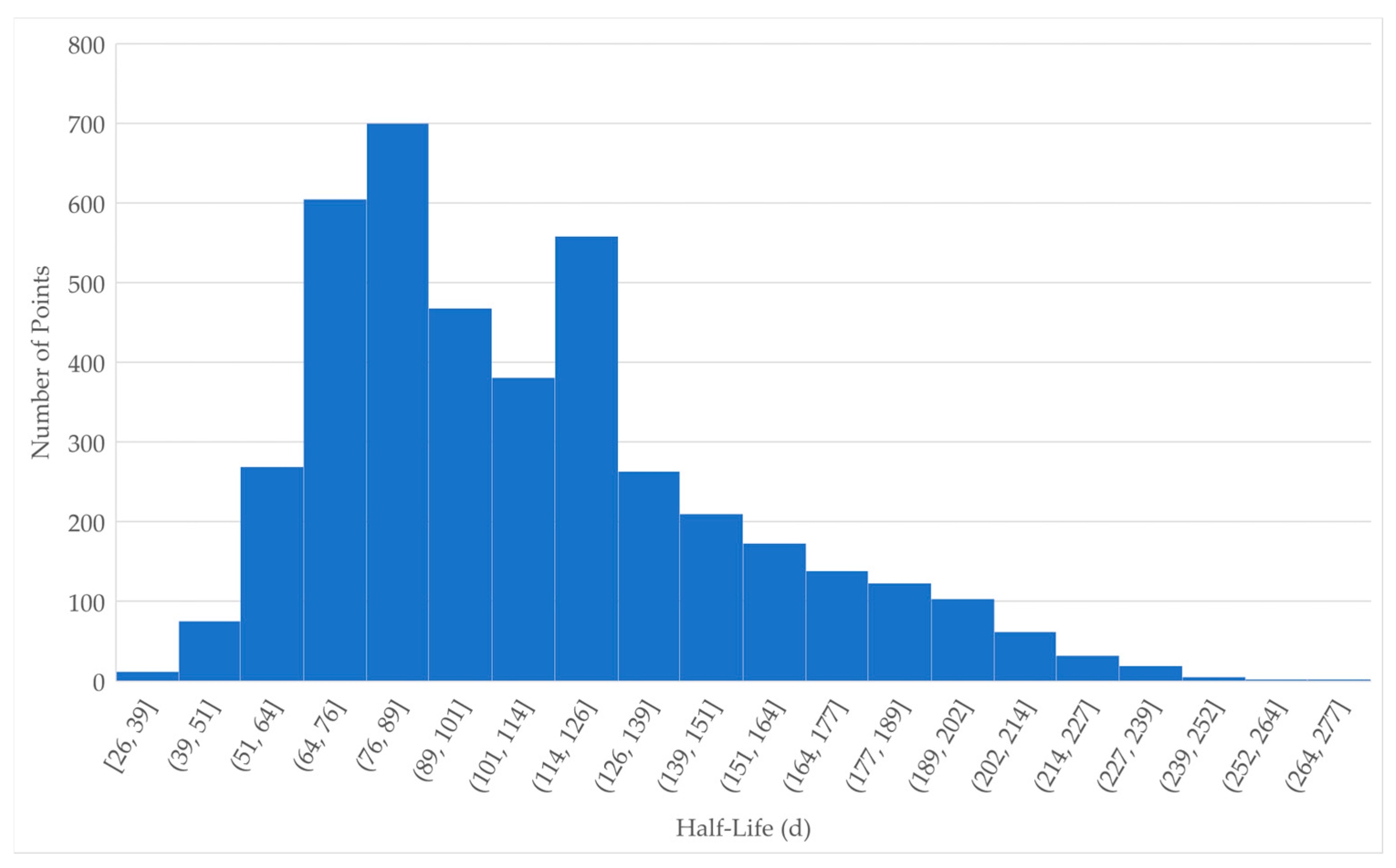
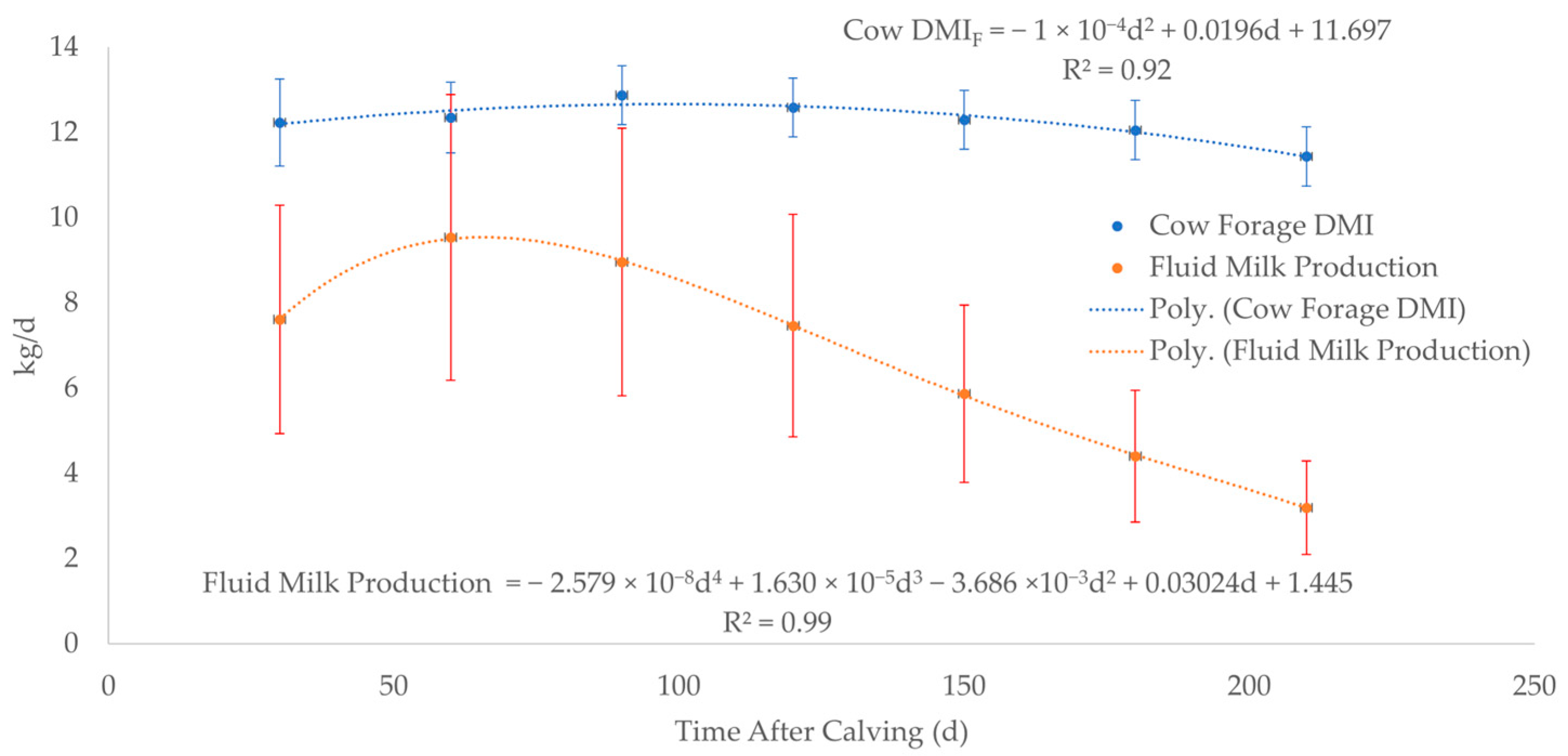
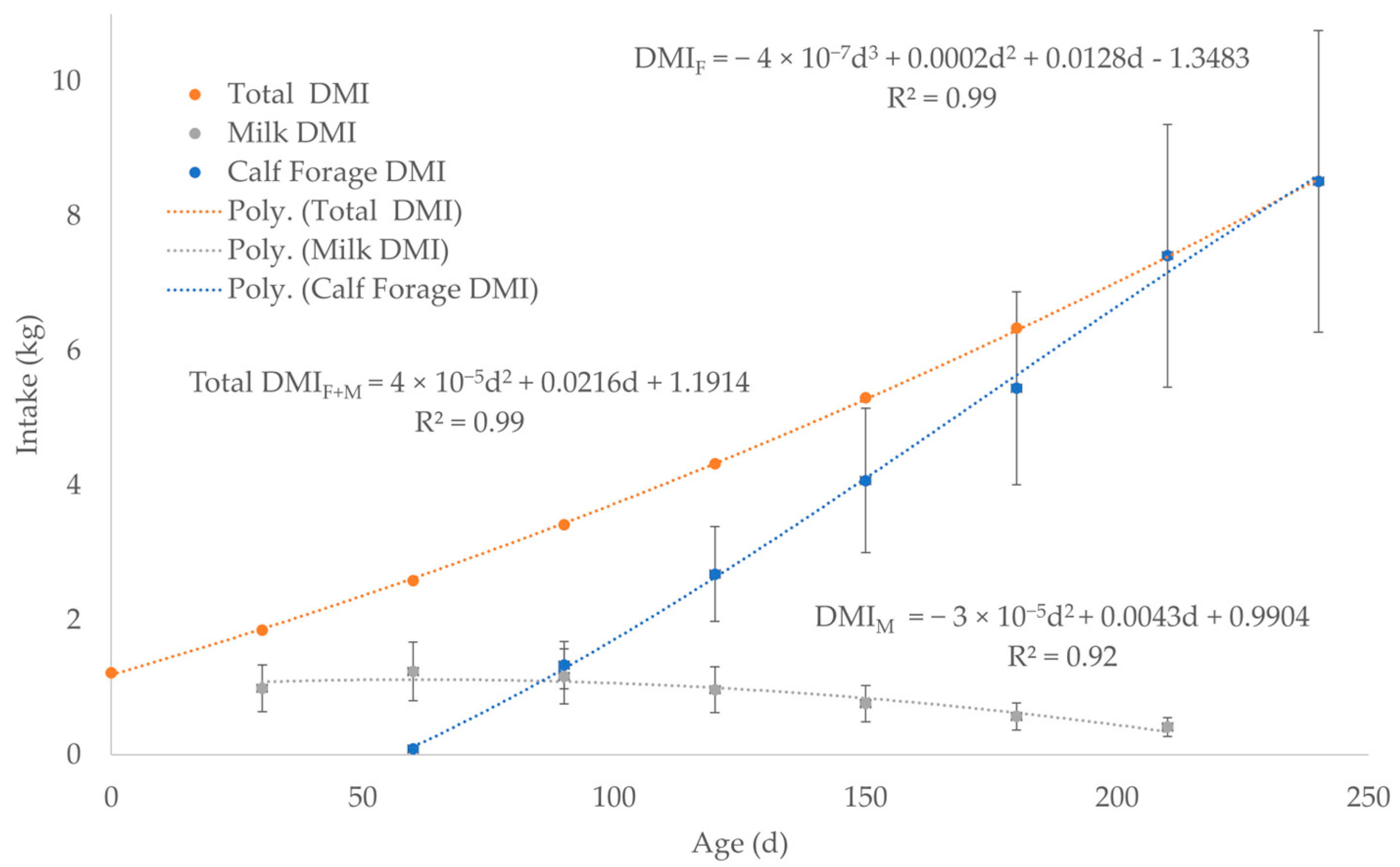
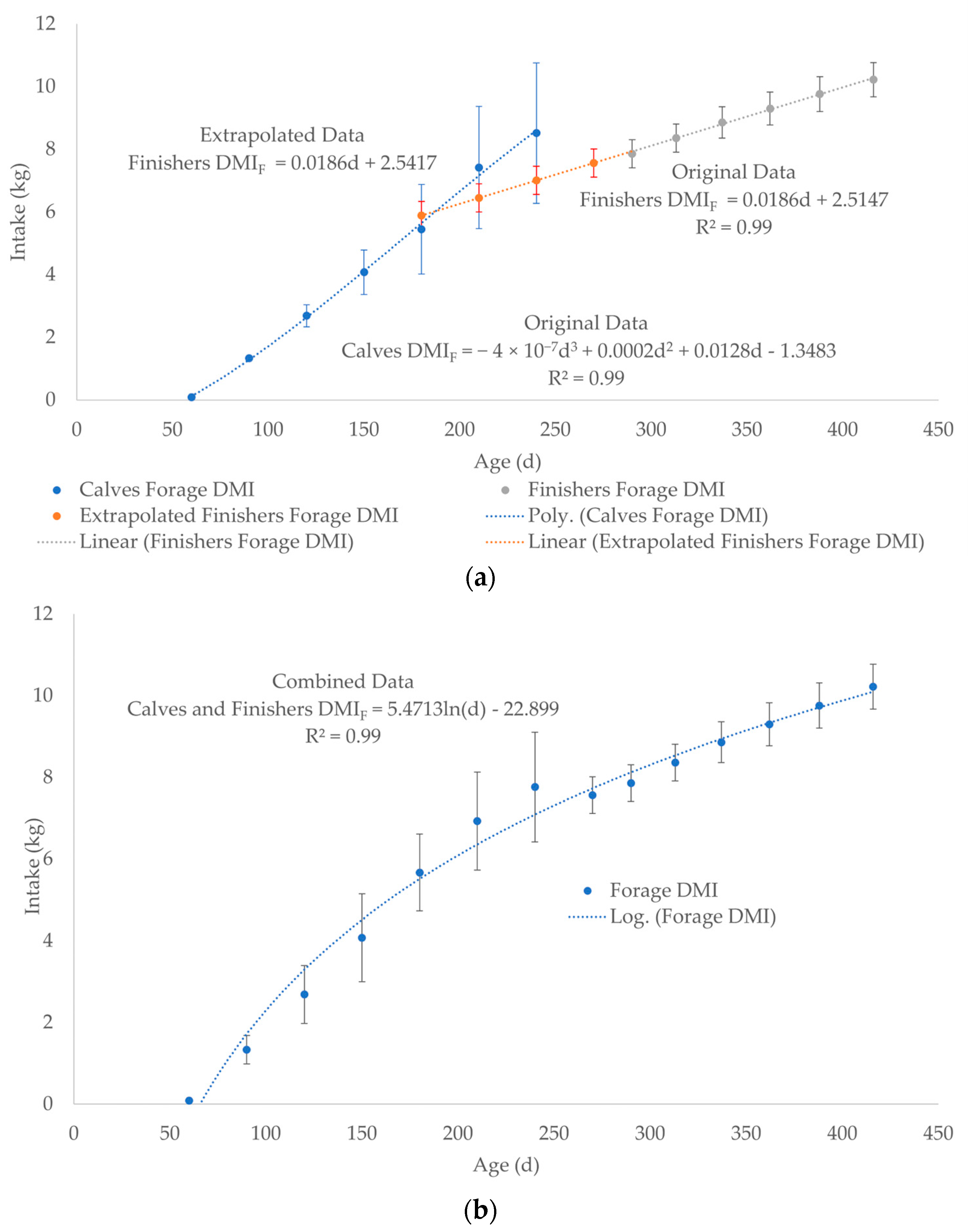
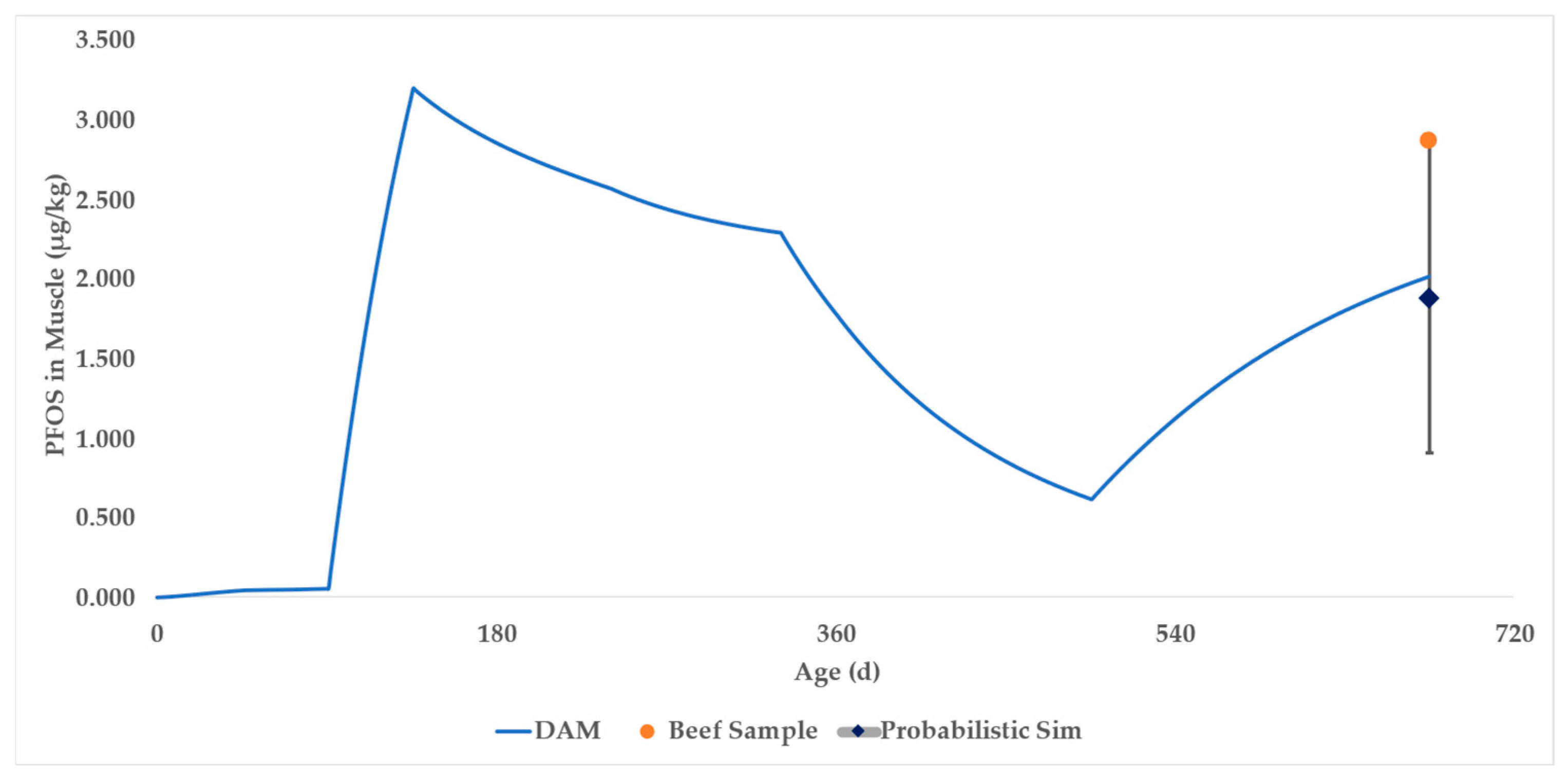
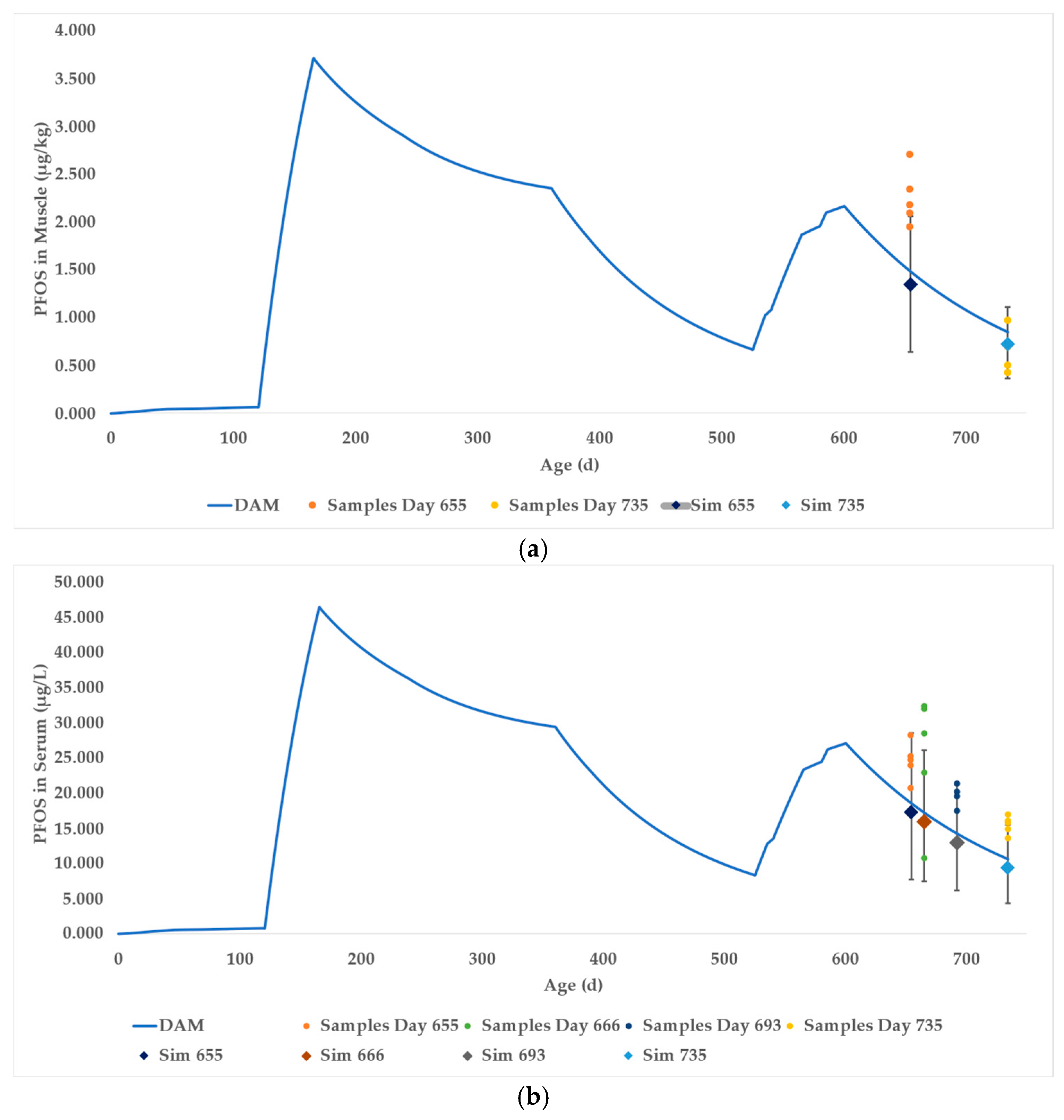
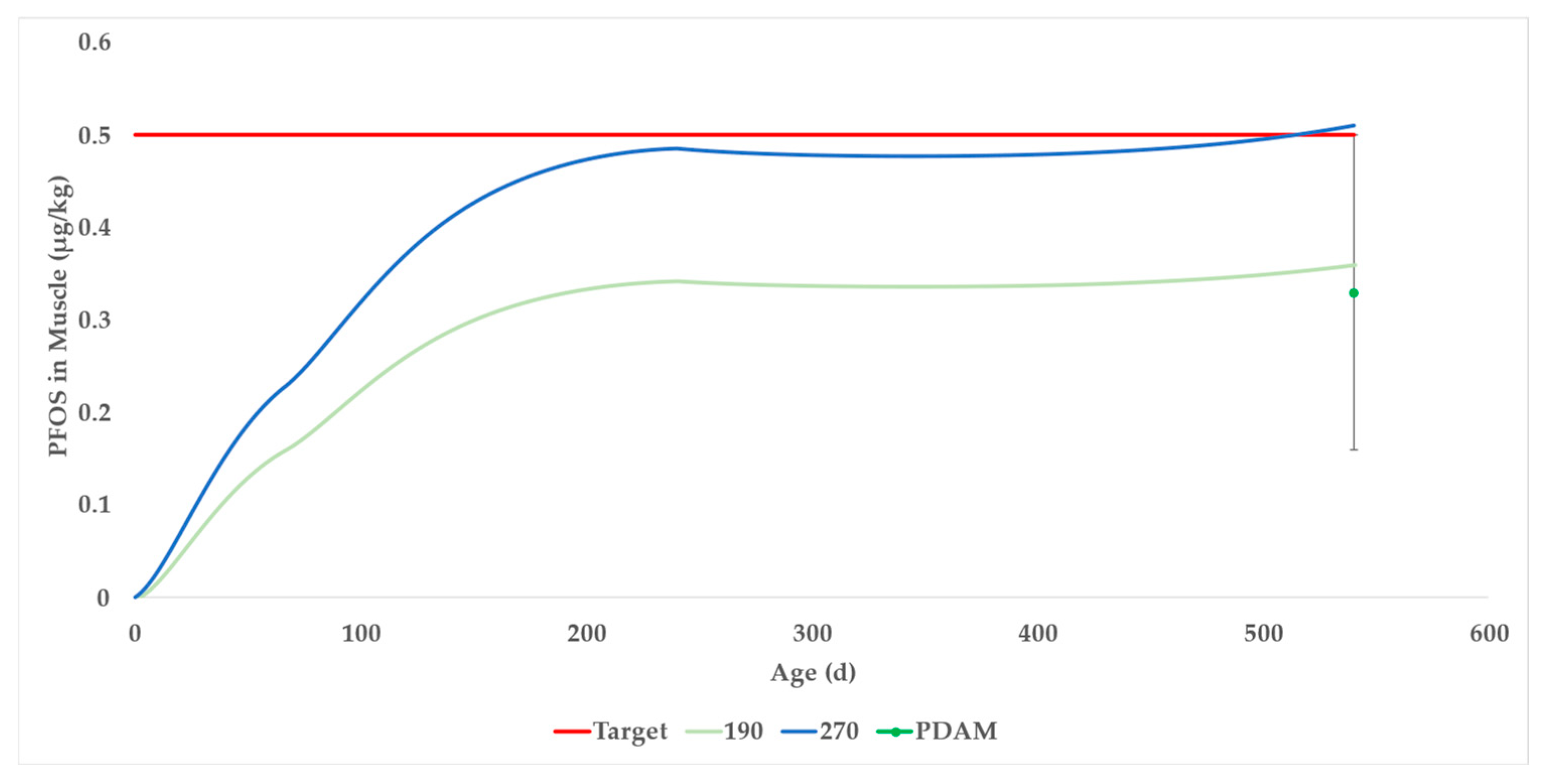
| Study | Tissue | Half Life | SD | Exposure | Type | Tissue | Duration | Divisor | Total Weight |
|---|---|---|---|---|---|---|---|---|---|
| [52] | Body | 114.2 | 22.84 | 1 | 3 | 3 | 1 | 1 | 9 |
| [46] | Steer Plasma | 120 | 4.1 | 1 | 3 | 1 | 3 | 3 | 3 |
| [46] | Heifer Plasma | 106 | 23.1 | 1 | 3 | 1 | 3 | 3 | 3 |
| [46] | Grouped Muscle | 165 | 33 | 1 | 3 | 3 | 3 | 3 | 9 |
| [47] | Serum | 74.1 | 13.4 | 3 | 1 | 1 | 3 | 2 | 4.5 |
| [47] | Muscle | 77 | 15.4 | 3 | 1 | 3 | 3 | 2 | 13.5 |
| Parameter | Unit | Value | SD |
|---|---|---|---|
| Half-life | d | 108.9 | 40.5 |
| Muscle:Body PFOS | 0.231 | 0.090 | |
| Muscle:BW | 0.361 | 0.117 | |
| Muscle:Serum Fraction | 0.080 | 0.016 | |
| Birth Weight | kg | 35.450 | 3.270 |
| BW’ | kg | 0.5584 + 2×0.001787d − 3×1.549×10−6d2 − 4×1.332×10−9d3 | ×0.35 |
| BW > 540 days | kg | BW + 0.32 | 0.112 |
| Cow DMI | kg | −1×10−4d2 + 0.0196d + 11.697 | ×0.062 |
| Milk Prod (Intake) | kg | −0.0000000257d4 + 0.0000163d3 − 0.003686d2 + 0.3024d + 1.445 | ×0.355 |
| Soil Intake | kg | 0.0243 × DMIF | 0.005 × DMI |
| Water Intake (Lactating cows) | L | 56.47 | 8.16 |
| Milk Transfer Factor | d/kg | 0.0213 | |
| DMI < 66 days | kg | 0 | |
| DMI > 66 days | kg | 5.4702 × ln(d) − 22.889 | BW × 0.0013 |
| Water Intake (Nursing Calves) | L/day | 4 × DMIF | |
| Water Intake (Finishers) | L/day | 40.84 | 12.87 |
Disclaimer/Publisher’s Note: The statements, opinions and data contained in all publications are solely those of the individual author(s) and contributor(s) and not of MDPI and/or the editor(s). MDPI and/or the editor(s) disclaim responsibility for any injury to people or property resulting from any ideas, methods, instructions or products referred to in the content. |
© 2025 by the authors. Licensee MDPI, Basel, Switzerland. This article is an open access article distributed under the terms and conditions of the Creative Commons Attribution (CC BY) license (https://creativecommons.org/licenses/by/4.0/).
Share and Cite
Edhlund, I.; Post, L.; Sklenka, S. A Daily Accumulation Model for Predicting PFOS Residues in Beef Cattle Muscle After Oral Exposure. Toxics 2025, 13, 649. https://doi.org/10.3390/toxics13080649
Edhlund I, Post L, Sklenka S. A Daily Accumulation Model for Predicting PFOS Residues in Beef Cattle Muscle After Oral Exposure. Toxics. 2025; 13(8):649. https://doi.org/10.3390/toxics13080649
Chicago/Turabian StyleEdhlund, Ian, Lynn Post, and Sara Sklenka. 2025. "A Daily Accumulation Model for Predicting PFOS Residues in Beef Cattle Muscle After Oral Exposure" Toxics 13, no. 8: 649. https://doi.org/10.3390/toxics13080649
APA StyleEdhlund, I., Post, L., & Sklenka, S. (2025). A Daily Accumulation Model for Predicting PFOS Residues in Beef Cattle Muscle After Oral Exposure. Toxics, 13(8), 649. https://doi.org/10.3390/toxics13080649







